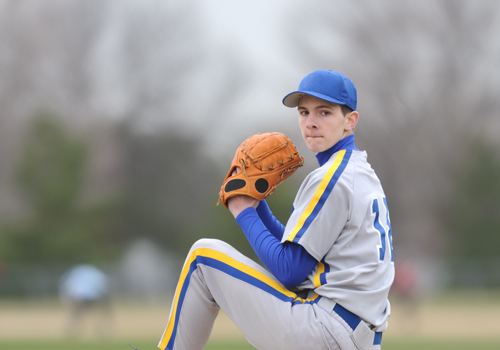
The Basics of Baseball Pitching Mechanics
Mastering baseball pitching mechanics is crucial for any pitcher aiming to excel. This section covers the essential components, including the proper grip, stance, balance, and windup and delivery techniques.
The grip on the baseball is fundamental to a pitcher’s control and ability to throw different pitches. The four-seam fastball grip, with fingertips placed across the horseshoe-shaped seams, is the most common and allows for maximum velocity and control. Other grips, such as the two-seam fastball or curveball grip, enable pitchers to throw pitches with varied movement and spin.
Next is the stance and balance on the pitcher’s mound. Begin with feet shoulder-width apart and the throwing arm side facing home plate. Distribute weight evenly on both feet to create a stable foundation. Maintaining balance throughout the delivery is key, as the lower body generates power while the upper body remains controlled and aligned toward the target.
Lastly, the windup and delivery techniques are vital. The windup involves an initial step back with the non-throwing foot, followed by a leg lift and a controlled stride toward the plate. The delivery, the actual throwing motion, should feature a smooth and fluid arm action, utilizing the entire body for maximum power and accuracy.
Mastering these mechanics takes practice, focus, and proper coaching. At The Jackson Clinics, our experienced coaches can help you refine your mechanics and boost your pitching performance. Contact us today to schedule a session and take your pitching skills to the next level!
Key Elements for a Powerful Pitch
Several key elements can help maximize your power and performance on the mound. By focusing on these aspects, you can enhance your pitching technique and increase your chances of success.
Generating leg drive and utilizing the hips are crucial for power and velocity. The lower body transfers energy from the ground up, propelling the ball toward the plate. By pushing off the rubber with your back leg and driving your front hip toward the target, you generate more force and speed in your pitches.
Arm action and follow-through are also critical. Proper arm positioning and usage during the pitching motion greatly impact accuracy and effectiveness. A fluid and efficient arm action, combined with a balanced follow-through, improves control and reduces injury risk.
Proper body alignment is essential for optimal mechanics. Ensuring correct alignment throughout the pitching motion helps maintain balance, generate power, and minimize arm stress. Coordinating every movement from the starting position to the release point is key to maintaining a strong and stable posture.
At The Jackson Clinics, we understand the importance of mastering pitching mechanics. Our expert team of physical therapists and trainers provides personalized guidance and training programs to help you improve your technique and reach your full potential on the mound. Contact us today to learn more about how we can assist you in perfecting your pitching mechanics.
Common Baseball Pitching Mechanics Mistakes to Avoid
Several common mistakes can hinder a pitcher’s accuracy and performance. Here are three key mistakes to avoid:
1. Overstriding and its impact on accuracy: Overstriding happens when a pitcher extends their stride too far forward during delivery. While a longer stride can generate more power, it often results in a loss of control and accuracy. Focus on maintaining a balanced stride length for better control.
2. Inefficient use of the lower body: Many pitchers rely too heavily on arm strength, neglecting the power generated from the lower body. Proper mechanics involve utilizing the legs, hips, and core muscles to generate power and maintain balance. Engaging the lower body effectively improves velocity and reduces arm injury risk.
3. Over-reliance on arm strength: Another mistake is over-relying on arm strength to generate velocity. While arm strength is important, it should be complemented by proper mechanics and the use of the entire body. Focus on fluid and efficient movements that distribute the workload across the entire kinetic chain, reducing arm strain and enhancing performance.
At The Jackson Clinics, we recognize the significance of proper pitching mechanics. Our team of experienced physical therapists and sports performance specialists provides personalized training programs and rehabilitation services to help pitchers optimize their mechanics and prevent injuries. Contact us today to learn more!
Drills and Exercises For Baseball Pitching Mechanics
Proper mechanics are crucial for performance and injury prevention in baseball pitching. Incorporating specific drills and exercises into your training routine can enhance your pitching mechanics. Here are three key areas to focus on:
Hip Mobility Exercises for Better Rotation: The hips are vital for generating power and rotation during the pitching motion. To improve hip mobility, include exercises like hip circles, hip flexor stretches, and lateral lunges in your warm-up routine. These exercises increase flexibility, allowing for a smoother and more efficient pitching motion.
Balance Drills for Improved Control: Maintaining balance throughout the pitching delivery is essential for accuracy and control. Incorporate balance drills such as single-leg squats, yoga poses, and standing on an unstable surface (like a balance board or foam pad) into your training. These exercises challenge your stability, helping you develop better balance and control on the mound.
Pitching-Specific Strength Training Exercises: Building strength in the muscles involved in pitching is crucial for power generation and injury reduction. Focus on exercises targeting the shoulders, core, legs, and back. Examples include medicine ball throws, resistance band exercises, plyometric exercises, and weighted ball exercises. Consult with a qualified strength and conditioning professional to ensure proper form and technique.
By incorporating hip mobility exercises, balance drills, and pitching-specific strength training exercises into your training routine, you can improve your pitching mechanics and enhance your overall performance on the mound. Always listen to your body, start with proper warm-up and cool-down routines, and gradually increase the intensity and volume of your training.
Did you know you have Direct Access* to Physical Therapy? No referral, no problem!

















